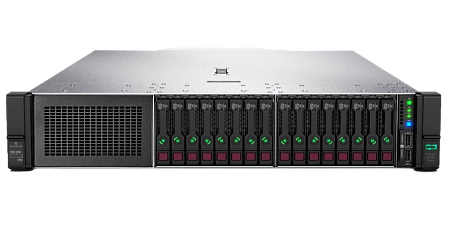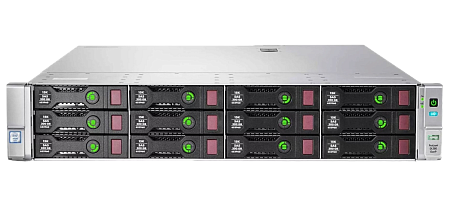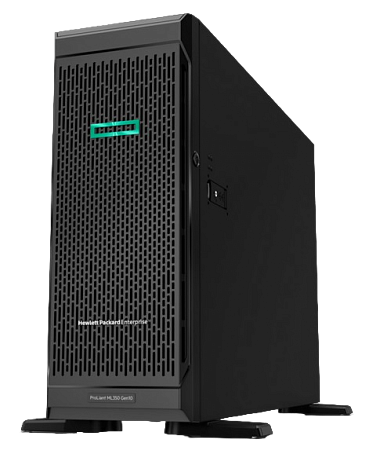HPE MSA (HPE Modular Smart Array) is Hewlett-Packard Enterprise's entry-level storage series
MSA is designed primarily for the data consolidation and for the storage, as well as for the virtualization systems.
What is MSA and what is it for?
The HP MSA kind is easy to learn, deploy and configure. Its affordable and the cost is effective with fast processors and double cache. Also, its expandable and upgradable according to the customer needs.

This is HPE MSA 2060.
The high efficiency of these systems is due to the ability to optimize their resources with the various options for host interfaces, using the maximum capabilities of SSDs, as well as support for Fiber Channel 8Gb / 16Gb, iSCSI 1GbE / 10GbE interfaces and FC / iSCSI Combo controllers, providing the ability to share array resources over two protocols.
In addition, HPE MSA supports a variety of the storage types, from a high-performance, enterprise-grade two-port SAS drives to low-cost, high-capacity SAS MDL or SATA MDL archiving drives. These arrays are hot-swappable for the hardware components, including the hard drives, the controllers, the power supplies, the fans and a have drive-removal protection based on a key or a dongle.
The HPE MSA storage systems are the right choice for small and medium businesses as they can accommodate growing data volumes while reducing storage costs for the organization. In companies these arrays often use to provide various IT services: support for email systems, accounting systems, file management (for example, Microsoft Exchange, SQL, SAP applications, Oracle).
MSA History
In the kinds of configurations HP MSA 1040 came to the market on 31-st March, 2014 with 1 GbE iSCSI, 8 Gb Fiber Channel and 10 GbE iSCSI controllers. This array supported consolidation, virtualization, and the application hosting projects, including email, databases, multi-media and was offered at an entry-level system price. Also, in the MSA of this version, the advanced tools for working with the data were implemented - Snapshot (the ability to create an instant copy of the current state of the LUN which can be used for the various purposes. At this moment 64 snapshots were available in the basic configuration and Volume Copy Services - sector-by-sector copying of data, full copying of the data to another logical disk.
HP announced the firmware updates for MSA 2040 Storage on 28-th July, 2015. These innovations made it possible to make the fast decisions and the accelerate applications by 45% (by 37,000 IOPS) without any additional costs. In other words to reduce the cost of deploying hybrid storage. Also, the HP MSA 2040 array with support for high-performance 6Gb / 12Gb SAS connections allows to connect directly to four application servers. This made it possible to create a redundant shared resource pool that scaled up to 384 TB. Its eliminated the need for a dedicated SAN fabric, making storage deployment much easier for the small businesses and saving up to 34% compared to other connectivity options.
HPE announced the release of the MSA 2040 Redesigned Storage Array on August, 2016, based on the innovative controller architecture with a redesigned processor. This device had four host slots and 4 GB of a cache memory per controller and included SSD drives which ensured faster response times for the storage applications. The maximum capacity of such arrays was 768 TB. They could accommodate up to 199 small drives and up to 96 large form factor drives. Management tools for HPE ProLiant/Blade Systems administrators and Snapshots tools for creating snapshots and Volume Copy for copying volumes were included as standard.
Also, HPE announced release of the drive for storage area networks (SAN) MSA 2042 on the basis of solid-state media on 16-th August, 2016. This drive was an entry-level storage platform with a built-in hybrid flash array for application acceleration and a high performance. The 800 GB MSA 2042 intended for the resource-intensive applications and according to the vendor was supposed to provide a 60% speed increase when working with the databases. Application response time reduced by 80% with the comparison of the previous model.
The current generations of Hewlett Packard Enterprise MSA
The fifth generation of MSA systems is represented by the base model MSA 2050 (flash-ready) and the hybrid model MSA 2052 with built-in flash drives. This line is designed to provide a high availability, a speed and a reliability of the business applications, for the data replication and for organizing the work of the remote offices and branches. Connecting to a host in the arrays is via FC, iSCSI, and SAS protocols. At the same time, the arrays don’t require the deep configuration and the special administrator skills. They help to distribute the growth of the workloads (tiering) and to ensure a high performance of the entire infrastructure. The MSA 2050 and 2052 systems use the same controllers and the differences between these arrays are due to the presence of additional options. By default, the MSA 2052 ships with two 800 GB SSDs, an Advanced Data Services license and 512 snapshots. The MSA 2050 doesn’t ship with SSD but with Advanced Data Services functionality except an automatic performance tiering. An extended snapshot license is available with a nominal cost.
Hewlett Packard Enterprise company announced the sixth generation of MSA disk arrays (MSA Gen6) at the beginning of September, 2020. The new line, like Gen5, provides SAS, iSCSI and Fiber Channel interfaces (iSCSI - 10 GbE and 10Gbase-T, FC - 16 Gbs).
The MSA Gen6 series represented by three lines:
- The HPE MSA 1060 storage system, a low-cost entry-level SAN designed for the small installations with relatively consistent capacity and a performance, especially suited to the businesses on a budget;
- The HPE MSA 2060 Storage System is a flexible SAN option for larger deployments. This model is suitable for the dynamic workloads, for the encrypted storage and for the scalable solutions such as video surveillance storage;
- The HPE MSA 2062 Storage System is a low-cost hybrid storage system suitable for the small and medium businesses that need one storage system for all tasks, designed for the different types of the workloads, both sequential and random access and high storage capacity.
The MSA Gen6 storage system designed in a 2U form factor with two drive options. The design of MSA Gen6 is different from Gen1 - Gen5. The MSA Gen6 chassis isn’t a compatible with the previous generations of array controllers, with the SFP optical connectors, with the power and cooling modules, with the drive modules, with the faceplates and with the expansion drive cages.
Upgrading from earlier MSA lines to Gen6 should be done in the form of a backup and restore of the data, using the RSR (Remote Snap Replication) utility, or using tools such as VMWare's Storage vMotion which makes it easy to migrate data from an old array to a new Gen6 array.
Hewlett Packard Enterprise MSA 6th Generation
All three models feature two ports per controller (four for the entire array) and support up to 4 drive cages in SFF/LFF form factors. At the same time, the baskets of the MSA 1060 array are supplied only for SFF drives but it is possible to use the baskets for the MSA 2060 (up to three pieces). In this configuration, SFF and LFF drives can be used together.

HPE MSA 2060 Rear view.
The supported MSA 1060 drive types:
- SSD RI (Read Intensive) with enhanced read/write capability, they can be used for a high performance tier and for reading a cache (Performance Tier/Read cache);
- SAS HDD 15/10K enterprise class for standard tier (Standard tier);
- SAS HDD 7.2K middle class (Midline) for archive the level (Archive tier);
- SED: Drives with automatic data encryption (Self Encrypting Drives).
Models of the MSA 2060 line - 16Gb FC (optional SFP interface with a transfer rate of 16 or 8Gbs), 10Gb iSCSI (optional SFP interface), 12Gb SAS. This line includes four host ports per controller (eight per array), supporting up to 9 drive cages.
The supported drive types, including ADS (Advanced Data Services suite) license:
- RI (Read Intensive) SSDs with increased read/write capability can be used for both Performance Tier/Read cache, including two 1.92TB RI SSDs.
- SAS HDD 7.2K middle class (Midline) for archive level (Archive tier);
- SED: Drives with automatic data encryption (Self Encrypting Drives).
At the same time, the MSA 2060 supports up to 240 SFF drives, or up to 120 LFF drives. Wiring simplified - 2m SAS-cable is no longer required to connect the last shelf.
The MSA 2060 and MSA 2062 lines are almost the same, except the MSA 2062 has a pre-installed ADS Suite (Advanced Data Services) license included in the array price.
The ADS Suite license provides the following features:
- two levels of a storage (Performance Tiering);
- up to 512 snapshots per system (without a license - 64 snapshots);
- RSR (Remote Snap Replication) function - replication of a local snapshot to a remote site.
Also, MSA Gen6 has following features:
- Thin provisioning - creating the volumes that are initially smaller than those visible to the host and increasing them if it necessary;
- Virtual Pool - combining several RAID groups into a common space which allows eliminating a performance limit of 16 disks for one RAID group (Wide striping);
- SSD Read Cache - cache extensions by local SSDs;
- Automated tiering 2.0 - acceleration of the applications by transferring the most demanded data to the fastest media, and less demanded to low-speed ones (SSD-Enterprise SAS-Midline SAS, SSD-Enterprise SAS or Enterprise SAS-Midline SAS);
- Advanced Virtual Snapshots – the instant snapshots using the ROW algorithm (without reserving space for snapshots).
Useful pool capacities formed from the disk groups. Each group can include drives of the same type automatically assigned a tier based on the chassis:
- SSD - performance level / SSD read cache;
- 15/10K Enterprise-SAS - standard level;
- 7.2K Midline-SAS - archival level.
Supported RAID levels - 1, 10, 5, 6, MSA-DP+. RAID 10, 5, and 6 groups can hold up to 16 drives, RAID 1 can hold up to 2 drives, and MSA-DP+ up to 128. The MSA-DP+ drive group provides:
- integrated redundancy (Integrated sparing);
- super-fast recovery (Super-fast rebuilds);
- improved sequential write performance;
- incremental expansion of a disk group.
All disk groups, except reading a cache, have failover mechanisms. The primary management tool is the Storage Management Utility (SMU) v4.
Specialists of our company are ready to help you purchase the server and select the necessary server configuration for any required task.














































